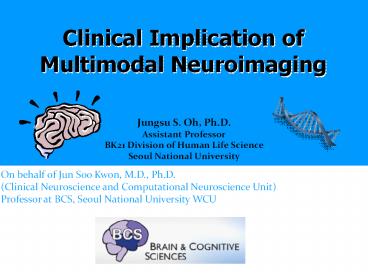Clinical Implication of Multimodal Neuroimaging - PowerPoint PPT Presentation
1 / 13
Title:
Clinical Implication of Multimodal Neuroimaging
Description:
Title: PowerPoint Presentation Last modified by: user Created Date: 1/1/1601 12:00:00 AM Document presentation format: Other titles – PowerPoint PPT presentation
Number of Views:198
Avg rating:3.0/5.0
Title: Clinical Implication of Multimodal Neuroimaging
1
Clinical Implication of Multimodal Neuroimaging
- Jungsu S. Oh, Ph.D.
- Assistant Professor
- BK21 Division of Human Life Science
- Seoul National University
On behalf of Jun Soo Kwon, M.D., Ph.D. (Clinical
Neuroscience and Computational Neuroscience
Unit) Professor at BCS, Seoul National University
WCU
2
Background
- Interests in brain function and connectivity have
much grown up in recent decades. - Synergic effects of Multi-modal/Multi-technique
Imaging, which is useful - not only for assessing chronic patients
- but also for detecting subtle changes in
- Ultra-high-risk (UHR) pathological subjects
- Neuro-plasticity groups
3
Example of High-risk group in the course of
schizophrenia
Healthy ? ? Severity of Symptoms
4
Basic Structures of Brain
- Gray Matter
- Functional activations
- Structural imaging
- Functional/molecular imaging
- White Matter (Tracts)
- Connecting distinctive functional regions
- Diffusion Tensor MRI for reconstructing pathway
information and estimating quantity/quality of
anatomical connectivity
5
Basic Principle and Properties of Diffusion
Tensor Imaging (DTI)
- Mean Diffusivity (Dm)
- Size of tensor
- (Degree of tissue microstructure disruption)
- Fractional Anisotropy (FA)
- Sharpness of tensor
- Normalized variance of eigenvalues01
- (Degree of fiber integrity)
- Mode (Ennis and Kindlmann, MRM, 2006)
- Proximity of tensor shape to a disc
- Degree of fiber crossing
- two principal axes disc shape
- Negative Mode
- Crossing fiber tracts ?1 ?2 gt ?3
gt
gt
Free Water Isotropic Diffusion
White Matter Tracts Anisotropic Diffusion
?1 ?2 gt ?3
6
Tract (Tractography)-Based DTI Analysis
- Not only diffusion properties but connectivity
- Not only visualization tool but quantitative
analysis tool of fiber tracts - Tractography Methods
- Most Basic Streamline
- Using principal diffusion direction(e1) only
- Euler Integration method
- Tensorline (regularized, using tensor
deflection), level set-based tractography (fast
marching tractography) - High-End Stochastic Tractography and High
Angular Resolution Diffusion Imaging (DSI, QBI)
7
Quantitative DTI analysis using Brodmann
ROI-based parcellation and tract parameterization
Application in Drug-naïve OCD patients
Shape-based parameterization
(Oh et al., NeuroImage, 2007)
(Oh et al., Unpublished data)
Application in UHR Schizophrenia patients
?
(Oh et al., in preparation)
(Oh et al., Human Brain Mapping, in press)
8
Functional imaging-based estimation of functional
activation and connectivity
Magnetoencephalogram (MEG)
Resting-state fMRI
- Decreased desynchronization of alpha rhythm in
UHR - Deficits of top-down inhibitory control
(Koh et al., Unpublished data)
- Deficits of early stage of auditory processing in
UHR - N1m and MMNm dipole moments may represent a
vulnerability marker in evaluating the risk of
transition to psychotic stage in UHR group.
(Oh et al., Annual Meeting of Biol Psychiatry
2008)
(Shin et al., Biol Psychiatry, in press)
9
Synergic Effects of Multi-modal/Multi-technique
Imaging
Connectivity
Structure
Function
Brain Imaging
IT
BT
Biomarker
To Better Understand the Etiology of SZ/ OCD/
To Better Detect High-Risk Groups for SZ/ OCD/
Genetics Study
BT
NT
Abbreviations SZ Schizophrenia OCD
Obsessive-Compulsive Disorder
10
Future Directions of High Risk Study
Large sample size and longitudinal study
Prerequisites
- Effective strategies for the recruitment of
high-risk groups - Continuous efforts for the follow-up studies
Combinational approach of structural and
functional imaging
Functional imaging-based connectivity
- Temporal activation in fMRI/MEG
- Intersubject variability of FDG PET
Structural imaging-based connectivity
- Mostly, DTI tractography-based approach
Structural Shape
- Cortical thickness, CC shape, Basal ganglia shape
Genetics-neuroimaging integration
11
An exemplary study of neuro-plasticity groups
the Baduk (Go) game experts
Working memory task-related fMRI
Voxel-based DTI analysis
(Park et al., Unpublished data)
(Lee et al., Unpublished data)
Integrated Anatomo-Functional Connectivity
12
Conclusion
- Multimodal neuroimaging including structural,
functional and genetic imaging will add to - finding biomarkers to detect subtle changes in
high risk groups - facilliating the development of treatment and
precaution strategies of psychiatric disorders. - Its application for assessing neuro-plasticity
groups (e.g., extraordinary IQ, meditation, Baduk
experts) looks promising as well.
13
Seoul Youth Clinic (SYC)
- Brief history of SYC
- Procedures in SYC
- Started SYC in 16 June, 2004
- Recruited 103 subjects of CHR/GHR SZ
- - 12 subjects conversion to psychosis (CHR
only) - - 18 subjects drop-up
- - 73 subjects follow-up
- Mediation Among the CHR groups, 36 subjects have
been taken for antipsychotics. - Related publications
- - Potential vulnerability markers within the
affective domain in subjects at genetic and
clinical high risk for schizophrenia.
Psychopathology. 2008, Apr - - Deficit of theory of mind in individuals at
ultra-high-risk for schizophrenia. Schizophr Res.
2008, Feb - - Pre-attentive auditory processing in
ultra-high-risk for schizophrenia with
magnetoencephalography. Biol Psychiatry, in press































